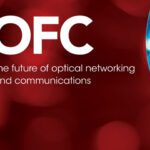OFC Celebrates High-Performance Optical Interconnects
Once again, OFC proved to be the premier showcase of high-performance optical and copper interconnects in communication and network applications.
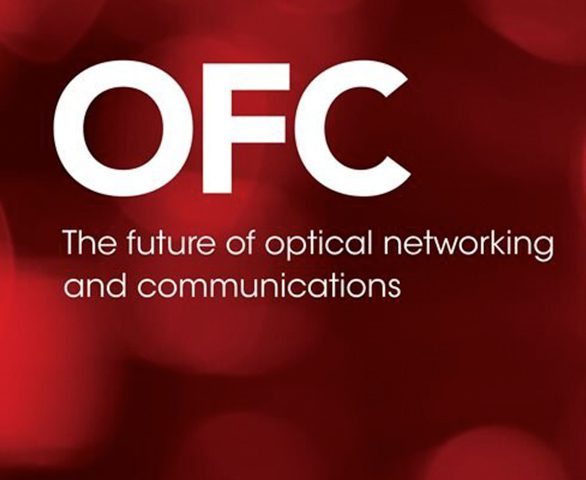
The 2023 edition of the Optical Fiber Communications Conference and Exhibition (OFC) roared back to normalcy after the muting effect of the COVID-19 pandemic. Over 11,500 participants from 70 countries accessed the latest advances in optical and high-performance copper interconnect technology. The sold-out expo floor hosted 515 companies from around the world, allowing face-to-face discussion of specific issues. The list of exhibitors included global industry leaders as well as many innovative startups, many of which used this venue to introduce new products and technologies. Nearly 200 technical presentations, workshops, seminars, and panel discussions presented over five days exposed both in-person and virtual participants to the most advanced interconnect technology. Topics ranged from Test & Measurement techniques of optical networks to advances in quantum computing.

The atmosphere on the exhibition floor and in technical sessions was optimistic. Prospects for optical communication continue to expand as existing interconnects are upgraded and new technologies are introduced. OFC 2023 showcased both optical as well as high-performance copper interconnect technology, reflecting industry preference for multiple options that allow the selection of the most economical interconnect that satisfies the needs of a specific application.
A few of the highlights observed at OFC 2023 included:
- Co-packaged optics (CPO) exhibits by many suppliers illustrated the interest this technology is generating. Many issues remain to be resolved, such as location of the laser source, internal fiber management, and field serviceability, but the promise of reduced power consumption and improved I/O panel signal density are key drivers of intense research and development. Several suppliers demonstrated models of the Optical Internetworking Forum (OIF)-driven External Laser Small Form Factor (ELSFP) concept. Advanced 102.4 Tb switches and beyond are likely to make CPO architecture essential. OIF celebrated its 25th anniversary at this year’s event and hosted several live interoperability demonstrations and technology discussions.
- High-performance twinaxial cable assembles remain a popular option in relatively short-reach applications. The standard passive direct-attach cable has been supplemented with variations that include active cables featuring amplification, equalization retiming, or a combination of each, which can extend the bandwidth and reach of a copper cable assembly. Cables are also available that utilize from 32-gauge to larger 26-gauge conductors to improve performance.
- Linear drive optical direct attach cable assemblies eliminate digital signal processor and retimer chips from the cable assembly reducing power consumption and resulting heat, both major objectives in new equipment design. Hisense Broadband announced an 800G linear optical direct attach cable targeting applications in artificial intelligence and machine learning.
- PAM4 modulation has been adopted for channels at up to 212 Gb/s. It is unknown if a higher order modulation will be required beyond that, but PAM 6 or 8 may be viable options.
- Pluggable optical transceivers were everywhere on the exhibit floor. The QSFP-DD and OSFP formats dominate high-end applications with up to 800 Gb/s performance and reach to 1000Km. InnoLight, for example, showed a comprehensive family of optical transceivers, including 10G, 25G, 40G, 100G, 200G, 400G, and 800G, paving the way to 1.6 Tb links.
- Pluggable optical transceivers utilizing coherent transmission feature integrated DSP chips and are being driven by demand for increased bandwidth, fiber capacity, automated management, durability, future proofing, reduced power, and cost.
- A battle is emerging between the use of QSFP-DD/OSFP pluggables and CPO in next-generation hyperscale equipment applications. Multiple chip vendors featured new coherent DSP chips designed for AI applications.
- Connector manufacturers as well as network operators are waiting for the release of the OSFP-XD pluggable specification, which is now expected by early summer 2023. Adoption of this new high-density interface will require trade-offs between higher panel density and lack of backward compatibility. The reduced profile of OSFP-XD offers increased I/O panel signal density and provides increased front panel cooling options.
- 200 Gb per lane technology was prominently featured by multiple vendors and is a key technology to enable 1/6Tb networking. IEEE is currently developing the 200G/lane specification that will enable broad adoption of this capability.
- Near-package high-density copper and fiber interconnects continue to gain traction as ever-shorter PCB trace insertion losses become unacceptable. The Amphenol Overpass family includes the micro Link-OVER and DensiLink connectors; Molex’s BiPass, Samtec Flyover®, and TE Connectivity’s AdrenaLINE Catapult and Sliver connectors are other examples of this class of interconnects.
The connector industry was well represented with approximately 30+ connector and cable assembly manufacturers, including industry leaders Amphenol Communications Solutions, Molex, Samtec, and TE Connectivity.

The large Amphenol booth featured a variety of high-speed copper and fiber optic solutions including a new 200Gb mid-board duplex optical transceiver delivering four channels at 56 Gb/s per channel.

Another display compared the thermal performance of OSFP800 and developmental OSFP-XD pluggable optical modules.

Molex showcased connectivity interfaces for co-packaged optics, as well as many products designed for optical wavelength management.
The Molex booth demonstrated a wide variety of optical connectors designed for applications in robotics, medical as well as network communications.
Molex offers a full line of OSFP and QSFP-DD transceivers including 800G DR8.

A Molex demonstration board included the company’s first-to-market version of the external pluggable laser module for CPO applications.

Samtec showed a 0.5-meter PCIe 6.0 AcceleRate high-performance cable assembly running at 64 Gt/s.
Another demonstration used linear drive technology to transmit 4 X 112 Gb/s through 100 meters of OM4 optical cable.
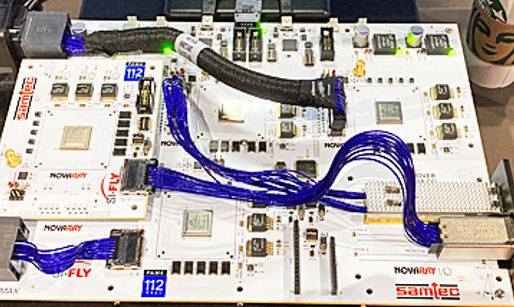
Additional displays featured the multiple options for internal high-speed interconnects including NovaRay I/O, and Si-Fly cable assemblies with rating to 112 Gb/s PAM4.
The TE Connectivity booth showcased multiple copper and fiber optic high-speed internal and external interconnect solutions.

A demonstration of a 224 Gb/s PAM4 channel used the AdrenaLINE Catapult near-chip connector through 0.5 meters of over-the-board cable.
TE showed an 800 Gb/s active optical cable running 8X 106.25 Gb/s PAM4 to a maximum length of 100 meters of OM4 fiber. QSFP-DD connectors reduced power consumption to less than 14 watts per cable end.
A 1RU rack shelf was populated with developmental OSFP-XD pluggable connectors providing 16 data channels at 112 Gb/lane and delivering 1.6 Tb per port.
Another display was running 224 Gb/s PAM4 per channel over one meter of a DAC passive copper cable for an aggregate of 1.6Tb/s.

The TE booth contained one of many examples of CPO packaging concepts shown at OFC this year.
A model showed a 112 Gb PAM4 over-the-board copper cable linking a 3.2Tb co-package ASIC using microLGA chiclet sockets to a fully populated array of QSFP-DD connectors.
OFC23 seminars, panel discussions, and exhibition provided an opportunity to gain insight into where innovation in next generation optical interconnects may be headed.
Several advanced optical fiber-to-PCB connector concepts utilize micro-mirror and lens technology to achieve 90° orientation of the beam were shown. Vendors featured micro reflective elements using glass or metal materials.
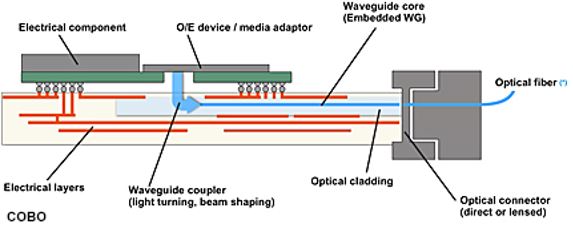
The Consortium for On-Board Optics (COBO) booth featured the Multi-mode Waveguide Interconnect System that proposes imbedded optical waveguide layers within a PCB and connected using micro-mirror technology.
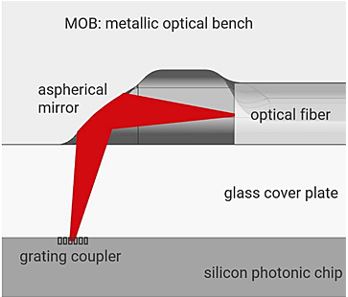
SENKO Advanced Components recently acquired CudoForm, a leader in the design and manufacture of precision stamped metal micro-optic components. Optical connectors designed for fiber to photonic chip utilizing this unique beam forming technology were prominently featured in the SENKO booth.

The Intel booth used OFC 23 to demonstrate an industry first 224 G PAM4 LR link over 1 meter of 26-gauge passive twinaxial cable provided by TE Connectivity.
Ayar Labs demonstrated the industry’s first 4 Tb/s optical chip-to-chip bidirectional solution. The SuperNova light source powers 8 fiber links using 64 wavelengths, each operating at 32 Gb/s for a total bandwidth of 2.048 Tb/s each direction using less than 5 pJ/bit.

Teramount, showed a fiber-to-chip interface that uses a series of micro mirrors to deliver low insertion loss to the optical layer of a silicon photonic chip.

Another approach to optical interconnects was demonstrated by Avicena. The company’s Light Bundle silicon technology uses arrays of micro-LEDs connected via multi-core fiber bundles to Si Detectors on CMOS ICs. This enables ultra-low power links of < 1 pJ/bit with up to 10-meter reach.

Lightelligence showed a prototype silicon photonic optical computing chip along with a single or 8 wavelength laser modules. These advances may pave the way to creating a future generation of optical computing devices.
Once again, OFC 23 proved to be the premier showcase of high-performance optical and copper interconnects in communication and network applications.
See Bob Hult’s coverage of OFC 2022 and his complete archive of technology coverage.
Like this article? Check out our Datacom Market Page articles and our 2023 Article Archive.
Subscribe to our weekly e-newsletters, follow us on LinkedIn, Twitter, and Facebook, and check out our eBook archives for more applicable, expert-informed connectivity content.
- Optics Outpace Copper at OFC 2024 - April 16, 2024
- Digital Lighting Enhances your Theatrical Experience - March 5, 2024
- DesignCon 2024 in Review - February 13, 2024
